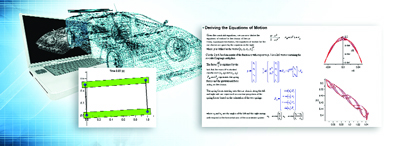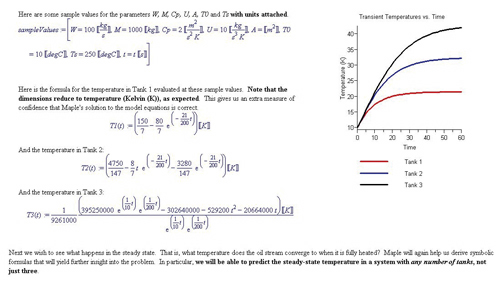Math Matters in Design
Every time an engineer reaches for a calculator or a scratch pad tocalculate or deduce a design parameter, critical engineering insightand knowledge is lost.
Latest News
March 1, 2005
By Paul Goossens
Although many would consider conceptual “back-of-the-envelope"calculations as peripheral to real design, these steps are oftencritical in managing design parameters as well as determining thedesign approach for the automated design phase. Without the right toolsand structure to capture these steps, however, the methodology becomesad hoc and difficult to replicate. All of us have felt the pains ofrecovering from a departing engineer who left the final design filesbut nobody could deduce how he got to the design.

We all need to “do the math” as a fundamental part of engineeringdesign. However, when things go wrong, very often it is due to amathematical error in the early design stages. If flaws are notidentified during the design stages the result can be costly, or evendeadly. We are all aware of the big news stories such as the ChallengerShuttle disaster through a faulty O-ring calculation, or the loss ofthe Mars Climate Orbiter due to a simple unit error. But this isn’tjust about “rocket science.” Math is used in the design and developmentof almost every product we experience today. Millions of calculationsare performed daily to support design decisions for products we willuse in the future. And every day, hundreds of engineering teams arewrestling with problems that stem from design flaws that were due tocalculation errors.
Faulty Beginnings
It is for this reason that billions of dollars a year are invested inCAE, MCAD, EDA, FEA, CFD, and other design analysis tools. In thesetools, the math is buried deep inside the software as rich sets ofmodels and algorithms that describe and facilitate simulations of realsystems in order to validate the designs.
But what about all the work and thought processes that go into thedesign at the conceptual stages? It is at this stage that the scope forerror and delay can be the greatest. So why do we treat our initialdesign calculation so casually? Why, when we need to make a designdecision, we still reach for a notepad, pen, and calculator to performsuch a critical task? The answer for many designers is that there areno viable alternatives. Specifically, they don’t believe that computers"do math” in the way that they do—equation formulation, algebraicmanipulations, simplifications, and so on.
This is true if one simply views computation tools like spreadsheets orprogramming languages as “doing math” on computers. And for manycomputer-savvy engineers, this is exactly what has happened. I havepersonally encountered many engineering projects where supportingcalculations end up locked inside cryptic spreadsheet formulas like((B12 + 2*$A$1)/A12)*2.3128.
The software system Maple (from Maplesoft) is an example of a genre ofsoftware—broadly categorized as interactive math systems—thatexplicitly manages math information in a way that is closer to the wayengineers work. Maple offers a range of solvers that cover all of theprincipal areas of engineering math and more.
Dynamic System Modeling and Control Using Maple
Engineers can use Maple to describe a dynamic system in a numberof representations—differential equations, transfer functions,state-space matrices—analyze the system and then develop thecontroller. Maple has all the power needed to derive and solve thesystem equations in order to analyze the time and frequency response,and stability, of the system (below).

The controller can then be developed and tested, and implementedas C-code for implementation in a microcontroller (above). The entireprocess is captured in a readable “self-checking” report that not onlydocuments the solution but the thought process that went intodeveloping it. This knowledge can be readily reused for other projects.— PG

Units and Dimensional Analysis
Interactive math tools like Maple can do more than solve equations,they can incorporate dimensional information for each variable that canthen be mapped to any system of units. Beyond providing a ready meansof converting from one unit to another, Maple mathematically combinesthe individual dimensions in an expression, simplifies the result, andthen maps it to another unit, if available (below). In this way, therisk of units error in the calculations is virtually eliminated.
— PG
Many call packages like Maple “spreadsheets on steroids” referring tothe depth and speed of the math solvers. This is a grossoversimplification as the fundamental paradigm of these systems issubstantially different from that of spreadsheets and most otherpackages used by engineers to do math calculations. These interactivemath systems are becoming increasingly important as daily productivitytools for engineers of all flavors for some very important reasons:
knowledge
Do more in less time—Engineers are under increasing pressure to bringnew products to market “better, faster, cheaper.” By using a tool thatnot only does the math for them but allows them to enter problems in anintuitive way and present the problem in a readable mathematicalformat, many engineers can reduce the time taken for performing thedesign calculations, and for delivering readable, reusable designdocuments, from months to days.
Reduce risk and design costs—The scope for error in engineeringcalculations is huge—from simply forgetting a minus sign to mishandledunits—and this can delay a project significantly. By using a platformthat has the computational breadth and depth to manage any level ofengineering calculation, including the ability to deal with dimensionsand units, you eliminate mathematical errors and reduce the risk ofdelay and escalating costs.
Make innovation happen—The pressure for competitive differentiationoften drives the need for the incorporation of new innovations intoproducts. Increasingly, those innovations start with a mathematicalpremise that is developed into a conceptual design. In situations likethis, it is impossible to predetermine the analytical requirements ofthe user since even he does not know where the project is going to takehim. Therefore, interactive math tools need to be sufficiently rich toaccommodate the most complex calculations. This computational"headroom” can only come about by incorporating the knowledge ofhundreds of mathematicians, accumulated over centuries, with the bestbrains in modern computer science, numeric analysis and symbolic(algebraic) computation.
Capture and reuse engineering knowledge—In some ways, the mostimportant opportunity for productivity gains has less to do withsolving a math problem but has more to do with the formulation,management, and deployment of the problem and its solution. Engineersdo more than calculate and simulate: they explore, collaborate,communicate, test, present, and manage all of the diverse range ofinformation they need for the job.
Systems like Maple go a long way in capturing the steps of supportingcalculations. They provide both the calculation environment thatpromotes fast, intuitive exploration and analysis, and a richdocumentation and solution deployment environment. You can do yourcalculations and as you do them, you can annotate with commentary,visualizations, reference links, etc. and in the end you have capturedboth the answers and thinking behind your analysis.
Paul Goossens is the director of commercial market development forMaplesoft. Send your feedback on this article through e-mail c/o [email protected].
Product Information
Maple
Maplesoft
Waterloo, Ontario
maplesoft.com
Subscribe to our FREE magazine, FREE email newsletters or both!
Latest News
About the Author
DE’s editors contribute news and new product announcements to Digital Engineering.
Press releases may be sent to them via [email protected].







